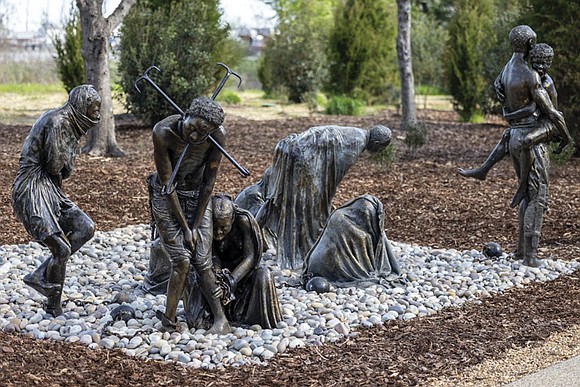Sculpture park aims to look honestly at slavery, honoring those who endured it
Associated Press | 3/21/2024, 6 p.m.

MONTGOMERY, Ala. - Visitors to the Freedom Monument Sculpture Park wind a serpentine path past art pieces depicting the lives of enslaved people in America and historic exhibits, including two cabins where the enslaved lived, before arriving at a towering monument.
Stretching nearly four stories into the sky, the National Monument to Freedom honors the millions of people who endured the brutality of slavery.
The monument is inscribed with 122,000 surnames that formerly enslaved people chose for themselves, as documented in the 1870 Census, after being emancipated at the Civil War’s end.
The sculpture park is the third site created by the Equal Justice Initiative in Montgomery, Ala., which is dedicated to taking an unflinching look at the country’s history of slavery, racism and discriminatory policing. The first two sites — the National Memorial for Peace and Justice, a memorial to people slain in racial terror killings; and The Legacy Museum: From Enslavement to Mass Incarceration — opened in 2018.
The sculpture park, which opens March 27, weaves art installations, historic artifacts and personal narratives to explore the history of slavery in America and honor the millions of people who endured its brutality.
Bryan Stevenson, the founder of Equal Justice Initiative, said after opening the first two sites that he felt there was more to do. Most plantation tourist attractions, he said, are centered around the lives of the family that did the enslaving. His goal was a place for visitors to have a “really honest experience with the history of slavery.”
“I do see it as a truth-telling space, a place where we can confront parts of our history and paths that are not usually taught,” he said. But he also believes it is ultimately a “hopeful place.”
“If people found a way to create family and future, despite the horrors of that institution, then we can do something comparable in our day to create a future that is less burdened by these histories than I think we’ve been,” Mr. Stevenson said.
The 17-acre site is nestled between the twisting banks of the muddy waters of the Alabama River and railroad tracks — the two transportation mechanisms used to bring people to the city’s slave markets in the 1800s. Visitors will be able to arrive by boat, essentially tracing the same path taken to deliver the stolen and trafficked people.
The park is opening as some politicians, including in the Deep South, try to put parameters on how race and history are taught in classrooms and in workforce training sessions. Mr. Stevenson says such push-back has always accompanied progress.
“I see this as a kind of a desperate act to hold on to the silence and the status quo and the burden of bigotry which we’ve coped with for so long. And I just don’t believe it will succeed because the truth is powerful,” Mr. Stevenson said.
The sculpture park includes major pieces from artists including Simone Leigh. Leigh’s Brick House, a 16-foot-tall bronze bust of a Black woman, sits as a formidable presence of strength at the entrance to the garden.
In a piece titled “Mama, I hurt my hand,” by Kwame Akoto-Bamfo, a child dragging a bag of cotton reaches out to show his injured hand to his mother, who balances a basket of cotton and an infant strapped to her back. Near them, a weary man with scarred skin and a splinted leg, sits in exhaustion.
The exhibits include two 170-year-old cabins that housed enslaved families on a cotton plantation, a whipping post, chains used to hold trafficked people and replicas of a transport box car and slave-holding pen. Interwoven between the exhibits are first-person accounts by enslaved people and formerly enslaved people about their lives.







